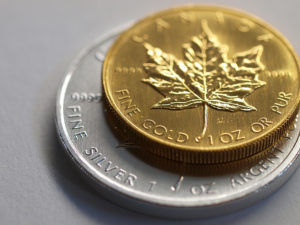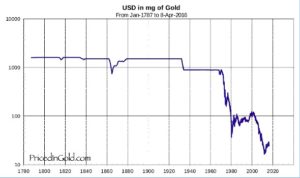
Whether intuitively or analytically, we all know that the dollar is not such a great money. Well, that’s putting a bit lightly isn’t it? The dollar is a downright terrible money when you take a closer look. Those who have been around a little longer grasp this reality more clearly. Like trying to walk up a downward-moving escalator, the momentum of a falling dollar is always working against you. This opposing force is felt more when engaged in economic planning of any kind; whether it’s starting a business, making an investment, saving for retirement, putting something away for a rainy day or simply making ends meet on a week to week basis, all of us have to work against a falling dollar(or fill in the blank with your fiat currency of choice.) But shouldn’t our money be working for us, not against us? Using gold as money puts the power back in the hands of its owner, where it belongs. But dollars don’t. Let’s explore how and why to change from a bad money to a good one.
Why do we keep using the dollar as money?
Firstly, because you are forced to pay your taxes with dollars. And technically it is illegal to use anything else for “cancelling debts”. While those are strong coercive forces to be sure, neither of them actually forces you to think in dollar terms. They certainly condition you to think in dollar terms as taxes must be paid and merchants must accept dollars so they tend to advertise prices in dollar terms. Prisoners in prison for a long time are subject to the severe psychological impact prison life can have on their mind – how they think, see the world and see others. And yet, there are always stories about some prisoners who manage to keep such assaults on their mind at bay. Thinking in dollars is similar. Conditioned as your mind may be, it is not totally enslaved to the dollar.You are in fact free to think in terms of a better money. And it is quite advantageous to do so as we will explain further. Of course, we think gold is the best money. So here is the case for why you should leave the dollar thinking behind and start thinking in gold terms.
The Value of Money
Money is commonly and inadequately defined as the “common medium of exchange”. This definition doesn’t tell us anything about whether the common medium of exchange is a good one or bad one. By good or bad we mean whether it helps or harms human flourishing and civilization. Does it coordinate and facilitate harmonious economic action such as trade, keeping accurate accounts, and precise economic planning. Economic planning is necessary for human flourishing and civilization. Planning in a good money as opposed to a bad one makes a big, big difference.
Carl Menger, the father of the Austrian School of Economics, preferred to define money in terms of its saleability or marketability relative to other economic goods. Marketability refers to the relative ease that particular good could be used in market exchange. There is always a cost to bring and exchange products at market. Therefore, the most marketable economic good was the one which permitted mutually beneficial exchange at the least possible cost. With this concept in mind, the most marketable good in any economy eventually becomes its money. It is important to remember that in Menger’s paradigm the marketability of a good precedes its becoming the common medium of exchange. The “money-good” only becomes the most common medium of exchange because more and more people discover that it works better than anything else they were using before. It makes planning more intuitive and accurate, it opens up new possibilities of value creation and exchange, and it makes execution easier.
The Properties and Functions of Money
Money has a set of defined properties (durability, divisibility, portability, sufficient supply, uniformity, recognizability, history or store of value, etc.). Money also has the following three functions:
-
Store of value
-
Unit of account
-
Means of exchange
We would like to add a fourth function which is the “to ultimately extinguish debts”. Such a fourth function was never needed in the history of economy until 1971. It is sorely needed now. Gold gladly and easily performs this function, but the dollar, sadly, cannot. But that is another topic for another time.
Now, the dollar is certainly very marketable today. Dollars are demanded not only all across the US economy but all across the globe. Make no mistake about it, we live and operate in the dollar system. If you want to do business on the world’s stage, you best be bringing your dollars with you. But don’t hate the players, hate the game, especially when the game stacks the deck against all the players.
e-VALUE-ating Money
Time is a great variable to measure monetary alternatives against. To borrow a concept from Taleb, “time will test the fragility (or antifragility) of all things.” Money (or monetary goods) are no exception. When we observe the dollar over short periods of time it does well both as a store of value, and means of exchange. But if we add more of the time variable to the dollar, we find that it begins to break down as an adequate store of value. To illustrate this point, let’s take a look at some charts showing the gold price of the dollar. Yes, that’s not a typo. If we are to measure the relative performance of the dollar we certainly cannot use the dollar as the measuring stick. That will always equal 1:1. We don’t prefer using other fiat currencies either such as the euro, yuan, ruble or yen. Because we are under the dollar system today those currencies are simply derivatives of the dollar and it doesn’t make sense to use a derivative as a measurement either. We suggest measuring the dollar against gold, this historical money good of humans for thousands of years until less than 100 years ago. Therefore, we are not so much interested in the dollar price of gold , but rather the gold price of the dollar. It’s an important distinction to make and we will come back to it later but for now just stick with me. Here are some charts showing the dollar in mg of gold over various timeframes. (Charts provided thanks to pricedingold.com)

Granted, that’s 200 + year chart, but the reality couldn’t be clearer. There have been some bumps along the way but the long term trend is firmly established. And from around 1971, that’s about as close to falling off a cliff as it comes. The implications are obvious for anyone who must plan across generations – the dollar just isn’t going to get you the goods (pun very much intended). Let’s zoom back in to around a ten year time frame to see if the dollar does any better there.

Ouch. That’s close to an 80% decline in a little over thirteen years. That comes to about a 6% capital erosion year over year. Stack that up against exponential technological progress which makes the cost of producing goods fall, and we have a very very bad money on our hands (and in our wallets). Unfortunately, this implies the dollar isn’t even suitable for planning ten years out. Who in their right mind would hold dollars for 10 years if they knew they would lose 80%?
When to use the dollar and when to use gold?
It’s not such an easy question to answer. Since late 2012, the dollar, priced in gold, has risen. Holding dollars starting in 2013 to 2016 has turned out to be a good decision. Although, the backdrop of history paints a very risky picture for dollar holders. Suffice to say, dollars do not score well in communicating value across time, especially over longer stretching timelines. Everyone has to answer that question for themselves. For me, I think three to five years is the maximum I would want to hold dollars without converting them into an another asset. Think for just a moment on what kind of incentives act upon market players when they can’t rely on the value of our commonly accepted medium of exchange when making economic plans…
Yeah…another article for another time.
How to break free from the mental dollar prison
For me, they key lies in the third function of money we haven’t yet talked about yet, the unit of account. Making the transition from “store of value” to “unit of account” would seem to be a pretty natural transition. If the dollar is not a good store of value over time, then why use it as a unit of account? The etymology of unit of account hearkens back to the French word numeraire. Numeraire is defined as “a basic standard by which value is computed.” Accounting and the units of account utilized only work if they accurately and precisely report back to us a snapshot of where value is. The heart of it all is that the dollar does not accurately or precisely account for value. It may do so on a short term basis. But over time it crumbles. The breakdown is significant for anyone who wants to save for more than a couple of months at a time. A different and better unit of account is necessary. Namely, one that accurately reflects the current state of value exchange as it occurs over time. We suggest gold.
Start thinking in Gold
Here is one simple and practical suggestion: Start calculating and measuring your net worth in gold. On a quarterly basis, calculate your net worth in dollars and then divide that number by the current dollar/gold price. This will give you, approximately, your net worth in ounces of gold. If the number of ounces is increasing every quarter then you can rest assured your net worth is increasing in value. If it’s not, then your net worth could actually be decreasing over time due to the falling and failing dollar. The longer you hold dollars the greater the risk you run that your net worth is increasing in bad money (dollars) while it’s decreasing in good money (gold ounces). Only when you start thinking of gold as money are you aware of that growing risk. Dollar thinkers are completely oblivious to it, which is part of what makes it so pernicious and deadly. Thus, we prefer to measure the dollar (and other currencies) in gold and not the other way around. It shows us where the true value is. It also permits us to see where all the price volatility comes from in today’s financial system. I’ll give you a hint, it’s not gold that’s volatile…it’s the d-o-l-l-a-r.
I know this is a very simple and basic step and it’s likely not going to change your world overnight. Nevertheless, it’s a step in the right direction. The more you can get in a habit of doing this, the more you will be able to accurately measure whether your wealth is in fact growing or whether it’s being eroded by forces beyond your control.
Have you ever heard the statement, perspective is everything? Well with money, it’s no different. Looking through the foggy lens of dollar money you will get a distorted and unclear vision of the world. Walking through life with unclear vision could lead to a very bumpy ride. Sooner or later, you are going to stumble and fall. There is a better monetary looking glass through which to view the world and its affairs – gold. Looking through the lens of gold will bring precision and clarity. You will be able to see things as they are and therefore be all the more more equipped to make your way safely.
A version of this article was originally published at Schiffgold.com